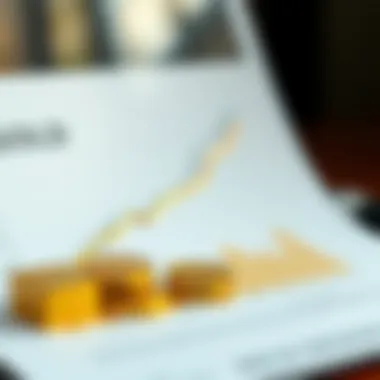Exploring the Influences on Raw Gold Prices


Intro
In today's financial landscape, the price of raw gold is not just a number; it's an indicator of economic stability, investor sentiment, and geopolitical intricacies. With the unpredictability of financial markets, knowledge about gold prices becomes paramount for anyone looking to secure their wealth. This article serves as a guide through the compelling landscape of raw gold pricing, unpacking the layers of influences and circumstances that contribute to its constant ebb and flow.
Understanding gold's pricing dynamics requires delving into the several essential factors at play. From market behaviors that seem to fluctuate with the wind to longstanding historical trends that appear as steadfast as the metal itself, essential groundwork needs to be laid out. The goal here is to help both novices and seasoned investors navigate this compelling asset's terrain with confidence and clarity.
As we venture deeper into the intricacies of raw gold prices, we will break down specific terminology, explore expert insights, and provide strategies for investment—all aimed at empowering you with the knowledge to enhance your financial strategy in the gold market.
Prelims to Raw Gold Prices
Gold has always captured the imagination of societies across the world, serving not just as a form of currency but as a symbol of wealth, power, and stability. Especially in times of economic uncertainty, raw gold prices become a focal point for investors. Understanding these prices can bring valuable insight into broader economic patterns, making it essential to grasp the factors that drive them.
Defining Raw Gold
Raw gold, often referred to as bullion, is the precious metal in its unrefined state, usually processed into bars or ingots. Unlike the gold jewelry that shines brightly on store shelves, raw gold has a different value proposition. Its worth is determined by several factors, including purity and weight. Investing in raw gold appeals to those who prefer tangible assets, as it holds intrinsic value that often withstands market volatility.
Investors diving into this market often encounter terms like "karat" and "purity percentages." Understanding these terminologies is crucial because they directly impact the pricing and investment potential. For instance, a bar with a 24-karat designation signifies nearly pure gold, making it more valuable in the market compared to a lower karat.
The Importance of Tracking Gold Prices
Monitoring the fluctuation of gold prices is not just a pastime for enthusiasts; it serves as a vital strategy for informed investing. It provides insights into shifts in the economic landscape, currency values, and even geopolitical events.
- Market Indicator: Gold often acts as a hedge against inflation. When prices rise, investors commonly flock to gold as a safety net, showcasing its liquidity in financial markets.
- Investment Decisions: Careful monitoring can help investors seize opportunities and avoid rash decisions driven by emotions. Prices can swing based on news cycles, economic reports, and global tensions.
- Wealth Protection: For individuals looking to secure their wealth against fluctuating fiat currencies, tracking gold prices becomes imperative. It aids in strategizing when to buy or sell, amplifying potential returns.
"A sharp watch on raw gold prices is akin to having a compass in an ever-changing economic landscape. It helps steer clear of treacherous waters and toward profitable shores."
Through understanding the nuances of raw gold pricing, one can appreciate its role not only as an investment but also as a steadfast guardian of wealth.
Historical Context of Gold Prices
Understanding the historical context of gold prices reveals a fascinating story of economic ebbs and flows. It gives us a lens through which we can view current trends and potential future movements in the gold market. This section is not just about numbers; it tells a tale of human behavior, economic strategies, and the inherent instability of global conditions. The fluctuations in gold prices over time offer insight into how various factors—from wars and recessions to technological advancements—have shaped the marketplace.
Gold Prices Through the Ages
Let’s take a stroll down the lanes of history to see how gold prices have evolved.
- Ancient Civilizations: Gold’s worth dates back thousands of years. The Egyptians, for instance, viewed gold as a symbol of immortality and power. They buried their pharaohs in gold-covered sarcophagi. Back then, gold was not priced in dollars but traded as a measure of wealth and status.
- Middle Ages: Fast forward to the Middle Ages, where gold’s value started seeing some fluctuation due to the rise of European monarchies and their obsession with gold coinage. It became the hallmark of economic strength. During this time, every ounce was closely watched, as it was often hoarded for times of war.
- The Gold Standard Era: The late 19th century gave birth to the gold standard, a monetary system where the value of currency was directly linked to gold. This stability led to global economic growth, but it also made economies vulnerable to gold supply crises. In 1929, the stock market crash made the world rethink the gold standard, and many regions began to detach their currencies from gold’s strong grip.
Each era molded public perception of gold, cementing its place as a stable asset. By exploring these historical milestones, investors can better grasp why gold is often viewed as a reliable investment, more so during turbulent times.
Key Price Fluctuations and Their Causes
The movements in gold prices tell diverse stories driven by socio-political and economic realities.
- The 1970s Oil Crisis: This decade saw oil prices skyrocket due to OPEC’s influence, which sent inflation soaring in the U.S. Gold prices climbed as investors sought security in a tangible asset during economic uncertainty.
- 2008 Financial Crisis: The mortgage crisis led to the collapse of major financial institutions, shaking confidence in economies worldwide. As stock markets plummeted, gold prices surged, hitting a then-record high as people flocked to gold investments, sheltering from the storm.
- Covid-19 Pandemic: More recently, the pandemic prompted massive government spending and significant stimulus efforts. In reaction, gold prices surged by over 25% in 2020 alone as investors sought refuge amid the chaos.


As history shows, gold doesn't just act as a shiny trinket; it plays a pivotal role in economic stability, often reflecting the broader picture of global financial health.
Recognizing these fluctuations is key for understanding how current events can impact the gold market. Whether one is a seasoned trader or a casual investor, keeping an eye on history allows for informed decision-making when it comes to gold investments.
Economic Factors Influencing Gold Prices
Grasping the economic factors influencing gold prices is essential for anyone looking to make sense of the dynamics at play in this precious metal market. Factors such as inflation, interest rates, and currency strength are not just numbers on a chart; they have real implications for investor behavior and market trends. When prices are on the rise or experiencing a slump, understanding these elements can make all the difference in successful investment decision-making. This article focuses on the nuanced interactions of these economic indicators, providing insights into how they shape the value of gold.
Inflation and Gold Valuation
Inflation often acts as a double-edged sword with respect to gold valuation. At its core, inflation erodes purchasing power. When people start to feel the pinch, many will turn to gold as a protective asset, effectively increasing its demand. Historically, during periods of rampant inflation, gold has often appreciated in value.
- Why does this happen? When prices for goods and services rise, the intrinsic value of currencies tends to decline. This prompts many investors to seek refuge in gold, leveraging its historical stability as a hedge against inflation.
- Illustration: In the late 1970s, the U.S. experienced significant inflation, pushing gold prices from around $35 per ounce to over $800 by 1980. That’s a major leap, and it directly correlates with public perception of inflation’s threat.
Assessing inflation’s impact on gold goes beyond just tracking numbers; it involves understanding why investors act on these fluctuating indicators.
Interest Rates and Their Impact
Interest rates are like the puppet strings in the market's theater, controlling how much investment wraps around gold. When interest rates are low, investors often find the returns on other assets lackluster, prompting them to seek alternative avenues like gold investments. Subsequently, when interest rates rise, the appeal of holding gold diminishes because the opportunity cost of not investing in interest-bearing assets increases.
- The relationship is fairly straightforward:
- Low Interest Rates: Easier access to borrowing and lesser returns on savings shift focus to gold.
- High Interest Rates: Fixed income securities start becoming appealing, drawing attention away from gold.
It's also worth noting that central banks play a pivotal role here. Decisions made during Federal Reserve meetings can send ripples through the gold market almost immediately. A rate hike might send prices tumbling, while a commitment to keep rates low could do the opposite.
Currency Strength and Gold Markets
Currency strength, particularly of the U.S. dollar, is another vital player in the gold pricing game. Generally, gold prices and the strength of the dollar travel in opposite directions. When the dollar weakens, gold becomes cheaper for foreign investors. This often leads to an increase in demand, pushing up prices.
- Key takeaway: The relationship between the dollar's strength and gold prices impacts global investment strategies. When investors lose faith in a currency's stability, they often flock to gold as a safeguard against potential financial turmoil.
- For example, during times of geopolitical tensions or economic crises, if the dollar flounders, it can lead to a surge in gold prices. Investors perceive gold as a safe harbor.
In summary, economic factors like inflation, interest rates, and currency strength play pivotal roles in influencing gold prices. Understanding these dynamics allows investors—from financial novices to seasoned traders—to navigate the complexities of gold investments more effectively. Remember, the value of gold is not just in its physical form; it is intricately tied to the broader economic landscape.
"Gold is a treasure, and he who possesses it controls the world."
Geopolitical Influences on Gold Prices
When examining the ever-fluctuating gold market, one cannot ignore the gravitational pull of geopolitics. This section will unearth how global political climates sway gold prices and why investors often flock to gold amidst turmoil. Understanding these influences is vital since such tensions and changes can create ripples across markets, prompting movements that both novice and seasoned investors should heed.
Global Political Stability and Gold as a Safe Haven
Gold has long been perceived as a protective asset, especially during times of uncertainty. When political upheaval strikes—be it through wars, protests, or government instability—markets often react negatively. In these moments, gold acts like a life raft, buoyed by its intrinsic value and historical role as a haven against the storm.
The correlation between gold prices and global stability can be seen through several lenses:


- Investor confidence tends to wane when tensions rise, leading to increased demand for gold.
- Countries rich in gold often see their currencies rise in value when their political systems remain steady; in contrast, political unrest can lead to a depreciation of currency, driving locals and investors to gold.
- Jackson Hole, where global economic dynamics often unfold, sometimes sees gold prices spike due to political announcements or decisions that upend existing frameworks.
Nevertheless, the interpretation of gold as a safe haven can vary by investor. Individuals in different geographical contexts might react differently to world events, but fundamentally, the allure of gold remains constant—a reliable storage of value when chaos reigns.
"In uncertain times, gold glitter seemingly brighter, coaxing investors to take cover beneath its illustrious canopy."
Trade Wars and Their Implications for Gold Investment
Trade wars can be likened to the clash of titans; they can shake not just particular sectors, but entire economies. When two or more nations engage in these fiscal conflicts, it creates an environment of uncertainty. Historically, escalations in trade tensions, like those in recent years between the United States and China, see a surge in gold prices. The rationale is straightforward: as tariffs, sanctions, and barriers rise, the anticipated volatility of currency and commodities increases.
- Escalating tensions lead to a depreciation of local currencies, making gold a more attractive option for protection.
- The speculation surrounding potential retaliatory measures often sends investors seeking refuge in gold to counter losses from other investments.
- Moreover, news of tariffs can disrupt the supply of gold itself, subsequently influencing prices as availability diminishes amidst demand.
For investors, the prospect of trade wars becomes a double-edged sword. On one side, opportunities arise as prices reflect external pressures; on the other, the inherent unpredictability demands vigilance and strategy. Understanding the waves of trade relationships allows investors to navigate their portfolios wisely. Know which geopolitical forces are at play, and adapt!
Overall, geopolitical factors serve as significant levers influencing raw gold prices. Whether through navigating through uncertain landscapes or interpreting the nuances of trade dynamics, the discerning investor must stay astutely aware of these dynamics. Analysis of such influences can bolster financial strategies and pave a pathway towards informed investment decisions.
Market Dynamics and Trading Gold
The arena of raw gold prices is not just a static landscape but a continually shifting mosaic shaped by myriad factors. Understanding the market dynamics and trading of gold is crucial for anyone looking to navigate this valuable asset. As the forces of supply and demand ebb and flow, traders and investors alike must adapt to these changing circumstances. Grasping the nuances of trading gold can yield substantial benefits, such as better investment decisions and informed market positioning.
One significant element in trading gold is the role of trading platforms. These platforms serve as the interface through which gold is bought and sold. They vary greatly in terms of services offered, transaction fees, and user experience. Here are some factors to consider when navigating the complexities of these platforms:
- User-Friendly Interface: The ease of use can impact your trading efficiency. A simple interface can lead to more thoughtful trading rather than rushed decisions.
- Access to Market Data: Reliable platforms provide real-time data and analytics that inform trading decisions. Having access to historical prices, for instance, can offer a clearer picture of trends.
- Fees and Commissions: Be cognizant of how fees can cut into your profits. Some platforms offer zero-commission trading, but always check for hidden fees.
- Security Measures: Protecting your investments is paramount. Opt for platforms that prioritize cybersecurity as a foundation of their services.
Understanding Gold Trading Platforms
Gold trading platforms range from traditional brokerage firms to modern online trading systems. Each brings its own set of advantages and disadvantages.
Using an online platform can make trading simpler, allowing you to conduct transactions in real-time from anywhere, as long as you have internet access. For example, platforms like eToro provide comprehensive insights into market trends, allowing both new and seasoned investors to act based on solid data. However, a downside might include less personalized support compared to traditional firms where a broker can highlight potential risks and rewards tailored to your financial situation.
When considering which platform to use, think about factors such as ease of navigation, the range of tools available for analysis, and community engagement, as with platforms like Reddit, where discussions on gold trading can provide valuable insights.
“Trading gold is as much about the strategies you implement as it is about understanding the info available to you.”
Quantitative Analysis of Gold Markets
Diving into quantitative analysis opens another crucial dimension in grasping market dynamics. This method relies on statistical and mathematical models to assess price trends and potential movements in gold prices. While this may sound complex, think of it as your compass in the trading landscape.
Common tools in quantitative analysis include:
- Moving Averages: These smooth out price data to identify trends over a specific period. Knowing when gold is on an upward or downward trajectory can provide a decisive edge in trading.
- Relative Strength Index (RSI): This indicator gauges whether the gold is overbought or oversold. A high RSI might suggest a downturn is near, enhancing your timing for selling or buying.
- Volume Analysis: Observing trading volume can indicate market strength. An increase in volume can signify strong investor interest, potentially leading to price movements.
By employing such quantitative techniques, traders can formulate strategies that allow them to not only react but also anticipate market movements, providing a solid advantage.
Understanding how to navigate trading platforms and apply quantitative analysis contributes significantly to making informed decisions in the gold market. The more equipped one becomes in these areas, the better positioned they are for successful investments in the fluctuating world of raw gold prices.


Investment Strategies for Gold
Investing in gold has long been viewed as a hedge against economic uncertainty. In this part, we look at why Gold investments are relevant and how they can serve strategic purposes for investors. Gold isn't just a shiny metal; it's a multifaceted asset with the potential to play a crucial role in diversifying portfolios. The significance of developing effective investment strategies lies in understanding that each investor’s goals, risk tolerance, and market outlook can vary widely.
Diversification with Gold Investments
One of the main attractions of gold as an investment is its ability to diversify an investment portfolio. When markets become turbulent, gold often moves differently than stocks or bonds. This creates an opportunity to reduce overall portfolio risk. Here are a few considerations:
- Negative Correlation: Historically, gold tends to have a negative correlation with equities. When stock markets decline, gold prices often remain stable or increase, providing a cushion against losses.
- Inflation Hedge: During periods of inflation, gold can retain its purchasing power better than fiat currency. Investors looking for a hedge against rising prices frequently turn to gold as a protective measure.
"Don't put all your eggs in one basket. Gold can be a solid choice to balance your investment weight."
- Geographic Diversification: Investing in different forms of gold, such as coins, jewelry, or exchange-traded funds (ETFs), means spreading risk across various avenues. This varying spectrum of ownership can help balance local economic risks.
By incorporating gold into your investment strategy, you might see a smoother growth trajectory over time.
Short-Term vs Long-Term Gold Investment Approaches
When it comes to investing in gold, one size certainly doesn't fit all - the approach can vary significantly between short-term trading and long-term holding.
Short-Term Investments
Investors with a keen eye for market trends might consider short-term trading. This involves taking advantage of price fluctuations, which can occur rapidly or due to geopolitical events or economic announcements. Here are a few points for short-term gold trading:
- Market Timing: Short-term strategies rely heavily on buying underpriced gold and selling when prices increase.
- Technical Analysis: Utilizing charts and patterns to predict gold price movements is common in this approach. Traders will often watch for signals or indicators to execute trades strategically.
Long-Term Investments
On the other side of the coin, long-term investors might adopt a different tactic by holding onto gold over extended periods. This strategy bets on gold's general upward trend over time, even amidst the market's ups and downs. Key points include:
- Stability: Long-term holding is less affected by short-term price volatility, allowing investors to ride out fluctuations.
- Historical Value: Over time, gold has historically appreciated, making it a safe bet for building wealth instead of just protecting it.
End and Future Outlook
Navigating the world of raw gold prices is akin to walking a tightrope; it requires both finesse and awareness of the broader context. The closure of this article seeks to illuminate why understanding the dynamics at play is vital for any investor, whether you’re just dipping your toes or have been in the game for a while.
Summarizing Key Points
Throughout this exploration, we’ve traversed various elements that shape raw gold prices. Here’s a quick recap of the pivotal ideas:
- Historical Trends: Gold’s value has fluctuated significantly due to various global events. Recognizing these past movements can help investors predict likely future trends.
- Economic Indicators: Factors such as inflation, currency strength, and interest rates heavily influence the gold market. Staying vigilant on these indicators allows for better strategy formulation.
- Geopolitical Events: Unrest or stability in key regions can alter perceptions of gold as a safe haven. Investors need to monitor the political landscape to hedge against potential risks effectively.
- Investment Strategies: From diversification to determining investment timelines, various strategies can enhance one's position in the gold market. Careful planning is crucial for optimizing returns.
This summary encapsulates essential takeaways, enabling investors to ground their decisions on informed insights rather than mere speculation. Each of these points interweaves, creating a complex and rich tapestry that demands critical examination.
Predictions for Future Gold Prices
Looking ahead, the trajectory of gold prices appears as a double-edged sword, influenced by multiple, unpredictable forces. Some predictions suggest the following:
- Rising Inflation: If inflation maintains its upward momentum, gold could see greater demand as a hedge, potentially pushing prices higher.
- Global Economic Recovery: Should nations bounce back from economic downturns, investor appetite for gold might wane, leading to price adjustments.
- Geopolitical Tensions: Heightened conflicts could reaffirm gold’s status as a safe haven, maintaining or increasing its price as people flock to secure their wealth from uncertainty.
"While no crystal ball exists to dictate price movements, historical patterns and current events provide significant contextual clues for savvy investors."
The prospect of raw gold prices in the future hinges upon these variables. Thus, remaining adaptable and keenly observant will empower investors to navigate the complexities of gold investment. Ultimately, understanding these dynamics aids in making sound financial decisions and reinforces gold’s prominent place in investment portfolios.







